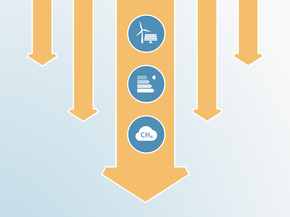Country summary
Overview
The new South African government under President Cyril Ramaphosa released the long-awaited draft of its Integrated Resource Plan (IRP 2018) in August, setting out a new direction in energy sector planning. The plan includes a shift away from coal, increased adoption of renewables and gas, and an end to the expansion of nuclear power.
The revised plan, if adopted, would mark a major shift in energy policy, which is remarkable for a coal-dominated country like South Africa. It aims to decommission a total of 35 GW (of 42 GW currently operating) of coal generation capacity from state-owned coal and utility giant Eskom by 2050, starting with 12 GW by 2030, 16 GW by 2040 and a further 7 GW by 2050. Costly coal capacity currently under construction (5.7 GW) would still be completed and another 1 GW of new coal capacity would be commissioned by 2030.
The plan also proposes a significant increase in renewables-based generation from wind and solar as well as gas-based generation capacity by 2030 and beyond, with no further new nuclear capacity being procured.
Implementing the IRP update of 2018 could bring South Africa close to meeting the upper range of its 2030 NDC target. However, we rate South Africa’s NDC target as “Highly Insufficient”. The implementation of the IRP update of 2018 would constitute significant progress in the transformation of the South African energy sector. To be in line with the Paris Agreement goals for mitigation, South Africa would still need to adopt more ambitious actions by 2050 such as expanding renewable energy capacity beyond 2030, fully phasing out coal by mid-century, and substantially limiting unabated natural gas use.
The 2018 IRP update is open for public comment until November 2018, but the Government has not yet communicated a timeline for the plan’s final adoption. The previous two proposed IRP updates in 2013 and 2016 were never adopted by Jacob Zuma’s Cabinet.
South Africa’s Nationally Determined Contribution (NDC) contains a target to limit greenhouse gas (GHG) emissions including land use, land use change and forestry (LULUCF) to between 398 and 614 MtCO2e over the period 2025–2030. This target is equivalent to a 19–82% increase on 1990 levels excl. LULUCF. Although South Africa is one of the few countries that has put forward absolute emission reduction targets in their NDC, we still rate this target “Highly insufficient”.
South Africa’s NDC is consistent with its pledge under the Copenhagen Accord, which proposed emissions reductions below business-as-usual (BAU) levels, incl. LULUCF, by 34% in 2020 and 42% in 2025. This represents a 17–69% increase in emissions excl. LULUCF in 2020 and a 17–78% increase in 2025 on 1990 levels, excl. LULUCF.
According to our analysis, under its currently implemented policies and continued low economic growth, South Africa will reach the less ambitious end of its emission reduction targets in 2020 and 2025, but will not meet its mitigation target in 2030. Emissions projections for 2030 are 16 MtCO2e higher than the upper end of the target for 2030. The CAT’s projections show South Africa’s emissions trajectory under its implemented policies in 2020 and 2030 are expected to increase by 68% and 82%, respectively, on 1990 levels excl. LULUCF. If South Africa’s economy were to grow again, emissions levels up to 2030 may be expected to increase.
Renewables deployment over the last two years has been hampered because Eskom, South Africa’s state-owned grid operator and owner of most South African coal plants, stalled for months on signing power purchase agreements with renewable energy companies—finally signing them in April 2018. This delay put the financial future of those companies at risk, along with the renewable energy capacity target, and has reduced the country’s renewable energy investment attractiveness. Uncertainty around Eskom’s financial solvency will remain a contributing factor to overall planning uncertainty and delays in progress on renewable capacity extension. A carbon tax bill has finally entered the Parliamentary process in February 2018 after two years of consultation. The final draft is expected to be completed by mid-2018 after further consultation.
Further analysis
Latest publications
Stay informed
Subscribe to our newsletter




